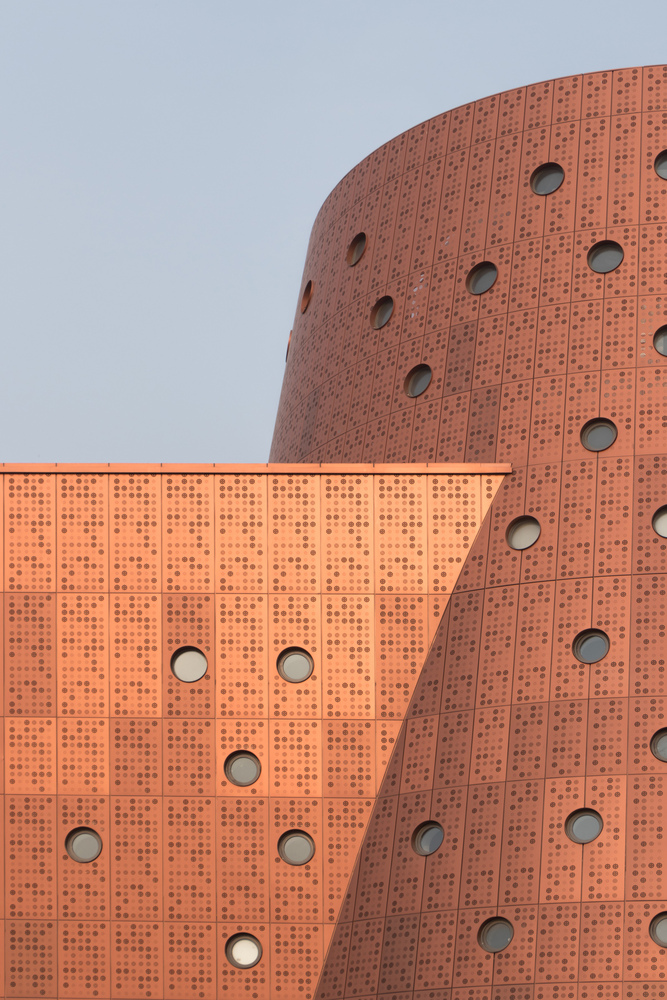Le Meridien Zhengzhou Neri-Hu Design and Research Office
2014-07-26 01:00
Text description provided by the architects. Framing a Journey through the City
在他们设计的勒梅里迪恩酒店,总部设在上海的奈利公司
In their design for Le Meridien hotel, Shanghai-based firm Neri&Hu envisions a new landmark for Zhengzhou, the capital of Henan province. Henan, once the ancient political, economic and cultural center of China and home to many Emperors, today welcomes the international traveler. To showcase Henan’s history through its Arts (of Literature, Nature, Food, Theater, and Pattern) the architects conceived of the building as an "archive" of new and old artifacts that becomes a point of discovery for residents and travelers alike.
在外部,档案被表示为悬臂堆叠的盒子,每一个仔细地由微妙的进进出出组成,以打破原来结构的庞大比例,同时提供一个动态的视觉对位给邻近的建筑物。为了区分体积,每个盒子前面的玻璃是一种稍微不同的绿色色调,盒子之间的负空间是透明的玻璃。盒子的两边都是黑色和咖啡色的金属面板,上面有一些以当地河南野玫瑰为图案的穿孔图案。两个漂浮的檐篷,由一簇青铜杆支撑着,带领游客到达正门。
Externally the archives are expressed as cantilevered stacked boxes, each carefully composed with subtle ins and outs to break down the bulky proportions of the original structure, while offering a dynamic visual counterpoint to the neighboring buildings. To differentiate the volumes the glass front of the each box is a slightly different tint of green and the negative space between boxes is clear glass. The sides of the boxes are clad in black and coffee colored metal panels textured with perforations patterned after the local Henan wild rose. Two floating canopies supported by a cluster of bronze poles leads the visitor to the main entrance.
这座25层楼高的建筑由一个5层高的公共设施平台和一座由350间私人客房组成的塔组成。在讲台上,灵感来自附近历史悠久的龙门洞,这是雕刻在石灰岩峭壁上的中国佛教艺术的最好例子之一。建筑表现的挖掘和雕刻是最强烈的经验周围的中央中庭,视觉连接多层公共空间的各种开口。上面的天窗穿透空间的自然光竖井,突出的沉积模式的灰色砂岩覆盖的墙壁。绿色的彩色窗户和一个广泛的定制设计吊灯安装填补了高空间的光和颜色的扩散。
The 25-storey building consists of a 5-storey podium of public functions and a tower of 350 private guestrooms. For the podium, inspirations are taken from the nearby historic Longmen Caves, one of the finest examples of Chinese Buddhist art carved into limestone cliffs. The architectural expression of excavation and carving is most strongly experienced in the various openings surrounding the central atrium that visually connect the public spaces across multiple floors. Skylights above pierce the space with shafts of natural light that highlight the sedimentary pattern on the grey sandstone clad walls. Green tinted windows and an extensive custom designed chandelier installation fill the high space with a diffusion of light and color.
在中庭顶部附近,洞穴的代表是一个更微妙的黑色木材盒,折叠到墙壁上。这些木箱是一个经常性的建筑特色,一丝有机轻盈并置与沉重的石头。在预功能区,整个天花板和墙壁主要是折叠的华夫饼盒,排列不规则,但在同一高度僵硬。某些盒子变成了透过中庭空间的窗户,而在水疗中心,一些盒子变成了嵌镜。
Near the top of the atrium, the cave is represented by a more delicate articulation of dark timber boxes which fold down onto the walls. These wood boxes are a recurring architectural feature, a filigree of organic lightness juxtaposed against the heavy stone. In the Pre-function area the entire ceiling and wall is dominated by the folding waffle boxes arranged irregularly but rigidly at the same height. Certain boxes become windows looking across the atrium space, and in the Spa a few boxes become inset mirrors.
在日本餐厅,木箱可能是最壮观的,在那里,整个核桃盒的天花板在高度和大小上都在不断地变化,其中几个最大的落差很低,形成了半私人餐厅。下面的地面模仿上方天花板的图案,就像起伏的景观一样,到处都是各种高度的橡木平台,其中一些打算供食客使用。一条蜿蜒的白色水磨石的小径,作为主循环,穿过剩余的空间。从内部延伸到外部,木箱的语言无缝地延伸到屋顶花园,它被照亮中庭的天窗占据着。
The timber coffer is perhaps most spectacularly realized in the Japanese Restaurant where the entirety of the ceiling of walnut boxes is constantly shifting in both height and size, several of the largest drop down low enough to form semi-private dining rooms. The ground beneath mimics the pattern of the ceiling above, and like an undulating landscape, it is populated by oak platforms of various heights, some meant to be occupiable by diners. A zigzagging path of white terrazzo carves its way through the leftover space as the main circulation. Extending from interior to exterior, the language of wood boxes continues seamlessly onto the Roof Garden, which is occupied by the very skylights that light up the atrium.
酒店还提供了另外两家餐厅,它们垂直地与楼层的战略切口连接在一起。中餐厅的私人餐厅是一系列黑色网眼卷,然后延伸到全天餐厅通过剪裁。从下面看,它们就像漂浮的灯箱,照亮了下面自助餐所布置的美食。全天候餐厅的地板和墙壁都是用定制的瓷砖设计的,这些瓷砖将Delft蓝色陶瓷的经典外观与中国绘画的传统笔触结合起来,同时融入了一个功夫主题,灵感来自该项目与著名少林寺的临近。
The hotel features two more restaurants which are visually connected vertically with strategic cuts in the floor. The Chinese Restaurant Private Dining Rooms are a series of black mesh volumes which then extend down into the All Day Dining Restaurant through the cuts. From below they appear as floating light boxes which illuminate the culinary delights laid out on the buffet stations below. The floors and walls of the All Day Dining are clad in custom designed tiles that combine the classic look of Delft blue ceramics with the traditional brush stroke of Chinese painting, while incorporating a Kungfu motif inspired by the proximity of the project to the renowned Shaolin Temple.
酒店的宝石是舞厅,它被设想为一个挂着金属网和水晶吊灯的吊笼,这是一场盛大的盛宴。墙壁向内倾斜接近这个房间的顶部,并允许空间为一条道路被开辟,作为酒店的另一个独特的特色。诗歌散步既可以作为健身动机的客人的跑步道,也可以是一条休闲散步的道路,有着风景优美的风景。这条环形轨道缓缓地向上倾斜,以俯瞰屋顶花园的全景而达到顶峰,然后回到地下,与其他健康俱乐部设施连接起来。
The jewel of the hotel is the Ballroom which is conceived of as a hanging cage draped with gold metal mesh and crystalline pendant lights, a theatrical celebration of opulence. The walls slope inwards near the top of this room and allow space for a path to be carved out, serving as another unique feature of the hotel. The Poetry Walk functions as both a running track for the fitness-motivated guest, or a casual strolling path complete with scenic landscape views. This looping track slopes gently upwards culminating in a panoramic outlook towards the Roof Garden and then descends back into the subterranean where it links up with other Health Club facilities.
客房设计的核心概念是光与暗的对比。起居和睡觉的区域由灰色墙壁和染色木材壁板组成,而最小的浴室仅用白色的地铁瓷砖覆盖,用白色刻蚀的玻璃板围起来,图案与外部的花纹相同。为了突破典型的酒店电梯大堂和客房走廊的无止境的重复和单调,整个客房塔有一系列三层的中庭,为艺术设施预留空间。每个中庭代表一个不同的主题,如神话,自然,或文化,并利用垂直给每个客房地板一个独特的片段的故事。
The core concept of the Guestroom design is a contrast of light and dark. The living and sleeping areas are defined by a palette of grey walls and a stained timber wainscot, while the minimal bathrooms are clad exclusively in white subway tiles and enclosed by a glass panel etched in white with the same floral motif as the exterior. To break through the endless repetition and monotony of typical hotel elevator lobbies and room corridors, the entire Guestroom tower features a series of three story atriums, spaces reserved for art installations. Each atrium represents a different theme such as Myth, Nature, or Culture, and takes advantage of the verticality to give each guestroom floor a unique fragment of the story.
This is the most extensive and largest scale inter-disciplinary design project Neri&Hu has undertaken, including: a re-design of the architecture from its previous concrete shell, full interior design from guest rooms to public spaces and restaurants, custom furniture design, signage design, landscape concept, and a few of the art installations. Through exploring different scales, textures, materials, and spaces, Neri&Hu created a showcase of archives by various ways of framing. Working closely with the client and the contextual references, Neri&Hu has curated a not only a spatial journey but a narrative sequence to serve the traveler and their experience of the city.
 举报
举报
别默默的看了,快登录帮我评论一下吧!:)
注册
登录
更多评论
相关文章
-

描边风设计中,最容易犯的8种问题分析
2018年走过了四分之一,LOGO设计趋势也清晰了LOGO设计
-

描边风设计中,最容易犯的8种问题分析
2018年走过了四分之一,LOGO设计趋势也清晰了LOGO设计
-

描边风设计中,最容易犯的8种问题分析
2018年走过了四分之一,LOGO设计趋势也清晰了LOGO设计








































































